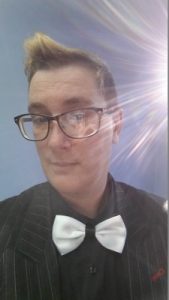 Today, we’re chatting with A. J. Fitzwater about their story in Battling in All Her Finery!
Today, we’re chatting with A. J. Fitzwater about their story in Battling in All Her Finery!
DV: Tell us a bit about yourself!
A. J. Fitzwater: There is a tale of one squeezed up with the mud through the cracks between bays and grapevine. There is the story where I grew from the purple hair down. There’s also the one where I was lovingly placed, fully formed and full of incandescence, by The Void in front of a laptop. Yet another where I was twisted together from the Words of the Great Mothers. Probably my favourite is I hatched from the egg of a great dragon, seen and unseen within this world. These are my truths.
DV: What inspired you to write “There Is Only the War” for Battling in All Her Finery?
AJF: I’m going to be terribly annoying and say the first image of the story came to me in a dream–that of a floating skull onto which innards, flesh, and skin grew from the neck down. I’ve been told my dreams are excessively weird and vivid.
At the time the story came to fruition, I was contemplating various themes of constant war–that of propaganda, surveillance, secrecy–and the forms in which anger is allowed to be expressed. Or in the instance of women’s anger, not allowed to be expressed. I’ve been asking myself through my fiction for a long time “what does a healthy expression of women’s anger look like?”. Unfortunately, I still don’t have an answer, and this story, with its examination of the full repression of women’s anger–emotionally and physically–goes in completely the opposite direction. But to come at the solution, we need to look at the failures.
Women in war, and the purposely made invisible history thereof, is something that I’ve been interested in recently. From reading Kameron Hurley’s “We Have Always Fought,” I went on to start reading up about things like the Bletchly Girls, the Women’s Land Army in WW1 and 2, New Zealand women in the armed services, women spies, and so on. One of my writing heroes, James Tiptree, Jr., was in the CIA. I’m not an historian by any means, but I felt it incumbent of me to at least have a passing understanding of what my foremothers fought and died for, only to have their achievements erased out of spite, shame, or disbelief, and to pass on the idea that a woman’s anger and strength has a place in the world, and a place in changing the world. I listen to and learn from those voices in such movements as Black Lives Matter, reproductive justice, and transgender rights, justice, and representation, many voices of which are women and genderqueer/nonbinary people.
DV: Your setting for this story seems so vivid to me. Was it inspired by any real-world locations, or made up wholesale?
AJF: I had the first scene in the field of flax in my head right from the start. Flax, the long-leaved brown and green varieties common to New Zealand, especially in swamp areas, is an imagery I like to work into my stories–there’s something familiar and comforting about it, reminiscent of childhood spent in the outdoors.
With the generational family home built into cliffside caves, I wanted to examine a life lived in harmony with the environment–the sun used for lighting, the river used to water the gardens, the thickness of the walls to heat and cool the rooms. I’ve been fascinated with the idea of shaped caves as workable housing environments in SFF ever since reading Anne McCaffrey’s Pern books.
DV: Do you have other stories set in the world of your story, or plans to write more in this world?
AJF: This is a one off story, though I do like the concept of the un-dead’s afterlife and community on the golden sands of a land far from the fear and annoyances of the living. Maybe I’ll revisit it sometime, see what the un-dead get up to in their spare time when they don’t have to fight the living’s wars for them.
DV: What’s on the horizon for you?
AJF: 2018 has been the year of working on Big Projects. I capitalize that because I have always been about short stories, and this year I wanted to challenge myself to write longer things. The first is a collection of stories set in my gaslamp solarpunk world of River City. I have had a few of these stories published, and wanted to flesh out the collection of characters–a bearded lady, a thief with psychic powers, an airship pilot who is a trans woman, a solar powered metal dragon–into a linked set of short stories and novelettes all set in and around a matriarchal, alt-history Northern African city. When it’s complete I’ll start shopping it about.
The second project is a novella about a found family of queer shapeshifters set amongst the forgotten history of New Zealand’s Land Girls in World War Two. It’s complete, and looking for a home.
Thanks, A. J.!
Follow us online: